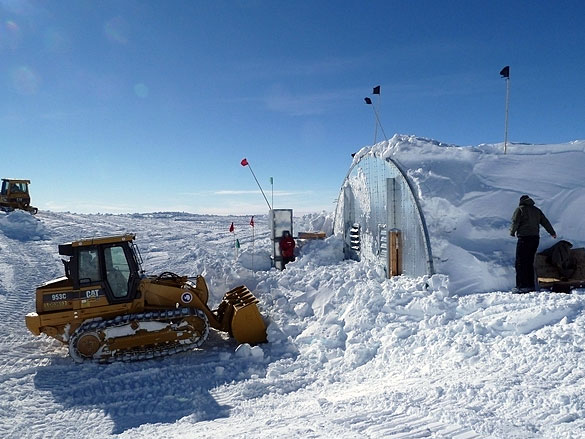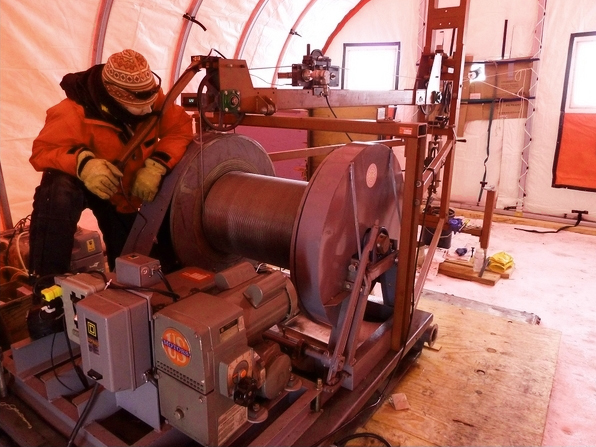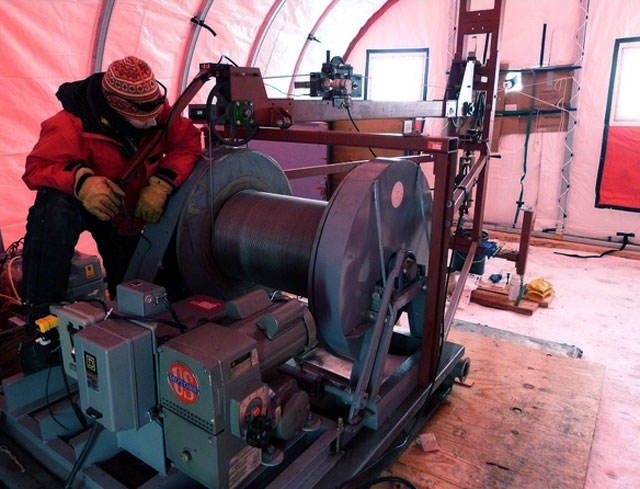|
Page 2/2 - Posted January 13, 2012
WAIS Divide ice core may resolve CO2, temperature debateCO2 is one of the primary greenhouse gases that most researchers believe is causing the planet to warm and the climate to change. They are particularly interested in determining whether natural increases and decreases in CO2 in the past preceded or followed temperature changes. That would help scientists better understand the relationship between temperature and CO2 today. Other ice core climate records have shown that CO2 lags temperature, but there is uncertainty about the timing because the age of the ice is different from the age of the trapped gases, sometimes on the scale of centuries or millennia. The WAIS Divide core should be able to constrain much of that uncertainty because the annual layering offers such a highly detailed view of the past. 
Photo Credit: Kristina Dahnert/WAIS Divide
The high snowfall that makes the WAIS Divide region appealing to scientists also makes it a difficult place to work. A tractor moves snow from the drilling arch.
“The ice core has more time resolution than we expected at the bottom, which is great because it allows us to really get into the details of how changes in greenhouse gases influence climate,” Taylor said. “There is more resolution than expected because the ice is melting at the bottom, and that results in less thinning of the ice by ice flow.” The extra ice collected this year contains ice from a time when CO2 was increasing rapidly, according to Taylor. Each meter of ice represents about 50 years of time. “We want to have another record that shows how natural increases in CO2, which were slower and smaller than what is occurring today, influenced climate,” Taylor said. “This will help us understand how the current human-caused increase in CO2 will influence our climate.” There is still about 50 meters of ice between the bottom of the hole and the environment below. The National Science Foundation (NSF) “We don't know exactly what type of material is under the ice, but it is likely to be soft-water-saturated ocean sediments,” Taylor explained, adding that there is not a subglacial lake under the drill site. Several U.S. and international projects are currently pursuing research elsewhere in Antarctica to access such lakes, which play a role in ice sheet flow. The final core was collected from the ice sheet at 9:16 a.m. on Dec. 31, according to Krissy Dahnert and Jay Johnson, DISC Drill 
Photo Credit: Kristina Dahnert/WAIS Divide
IDDO driller Elizabeth Morton assists with borehole logging operations.
“This moment has been a long time in the making, and words cannot describe the pride we feel in having completed this considerable task,” they wrote on the WAIS Divide Ice Core project website But the job isn’t over yet. WAIS Divide scientists now plan to send instruments into the open borehole to collect additional information and samples. For example, volcanic ash layers in the surrounding ice detected by what scientists call borehole logging will be useful for helping date the core. In addition, testing will begin this season of the replicate-coring drill system designed and built by IDDO. The smaller drill will fit into the original borehole, which is about 13.5 centimeters wide, and core into the side, retrieving more ice for analysis from layers of particular interest. The replicate-coring component of the project is expected to be finished by the 2012-13 field season. The field camp and all of the associated equipment, including a large arch facility that houses the drill, will then be broken down and removed. “We are on schedule for starting the logging of the extended borehole tomorrow morning,” Severinghaus wrote on the WAIS Divide website on Jan. 1. “Replicate coring looks likely to start on schedule, too.” For a complete list of all NSF-funded projects related to WAIS Divide, see the WAIS Divide webpage of funded projects |





